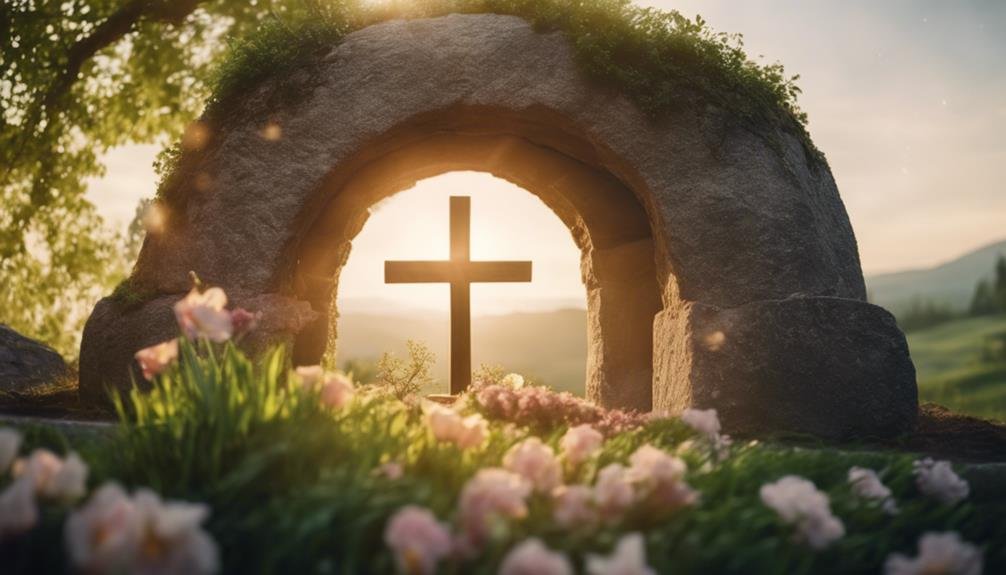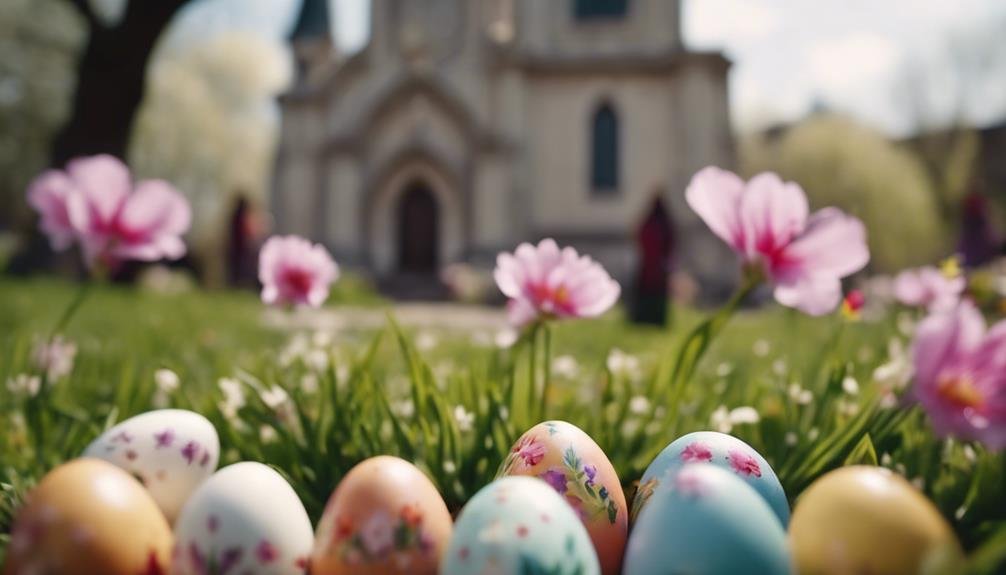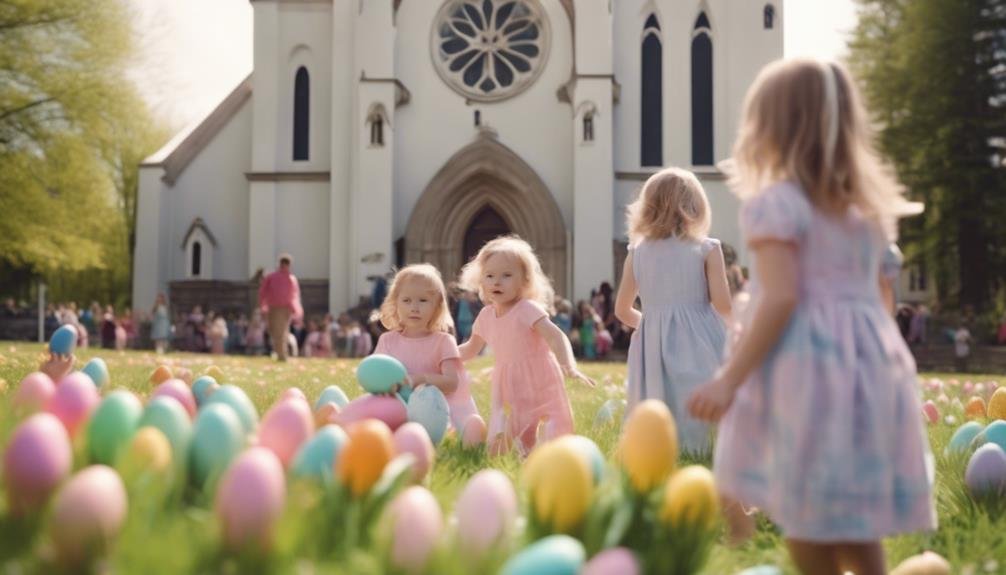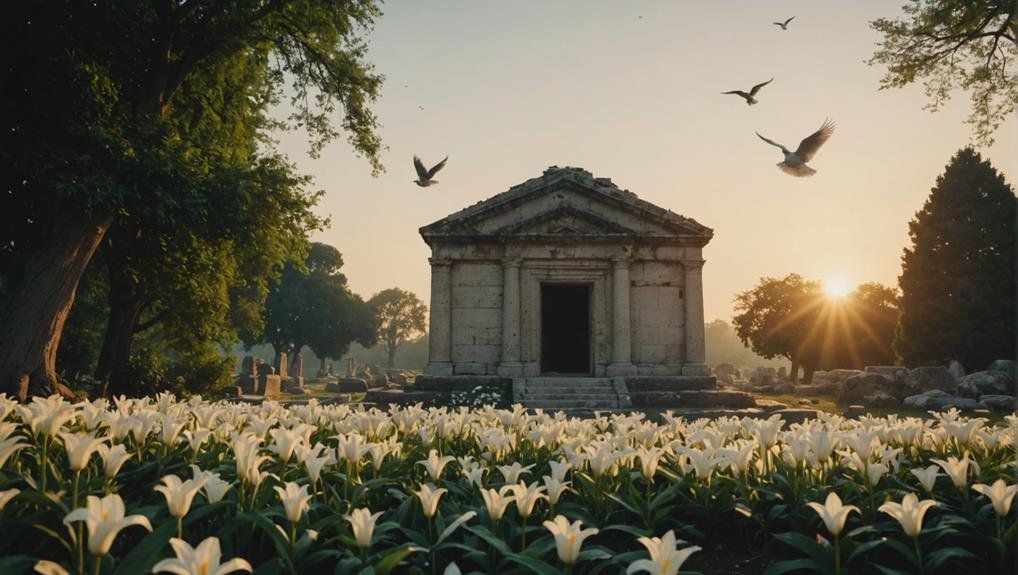You might wonder how the origin of easter in Christianity celebration intertwines ancient pagan traditions and the Resurrection of Jesus Christ. This fusion not only marks the end of Lent but also highlights themes of rebirth and redemption. By understanding Easter’s origins, you can grasp its profound impact on Christian theology and worldwide traditions. You’ll uncover deeper layers of this rich celebration as you explore the ancient roots, early adaptations, and the significance of symbols like the Easter Bunny and eggs. So, how did these diverse elements come together to form what we now recognize as Easter?
Key Takeaways
- Easter celebrates Jesus Christ’s Resurrection, symbolizing victory over sin and death.
- It originated in the early Christian community and was linked to the Jewish festival of Passover.
- Central to the Christian faith, Easter affirms the promise of eternal life.
- Early Christians adapted pagan spring traditions to incorporate symbols like eggs and bunnies.
- Easter is determined by the first Sunday after the first full moon following the spring equinox.
Ancient Pagan Roots

Many of Easter’s traditions can be traced back to ancient pagan spring celebrations. These origins are deeply rooted in the festivities dedicated to Eostre, the pagan goddess of spring and fertility. People have historically celebrated renewal, rebirth, and new beginnings during spring as the earth awakens from winter’s grip.
The celebration of Eostre included symbols like the Easter Egg, which represented fertility and new life. Eggs, hidden under the earth and then emerging, mirrored the rebirth of nature. This connection between eggs and springtime can be seen in how we decorate and hunt for Easter Eggs.
Eostre’s festival also featured other symbols of fertility and renewal, such as rabbits, known for their prolific breeding. These symbols were seamlessly integrated into what we now recognize as Easter traditions. Over time, the practice of celebrating Eostre’s springtime festival evolved, but the core themes of renewal and fertility remained.
Understanding these pagan origins provides insight into how deeply our modern Easter customs are intertwined with ancient spring rituals. By acknowledging Eostre’s influence, you can appreciate the rich historical tapestry that underpins this vibrant celebration.
Early Christian Adaptation
You might wonder how early Christians adapted Easter to fit their beliefs.
They referenced biblical events and embraced existing spring traditions, blending them into their practices.
Through this syncretism, they established rituals that have endured through centuries.
Biblical References to Easter
Early Christians looked to the New Covenant Gospels to find Easter’s roots in the Resurrection of Jesus Christ. The Gospel accounts describe Jesus’ Resurrection as a pivotal event, making Easter a cornerstone of the Christian faith.
As you explore these texts, you’ll see how the resurrection narratives shape this significant holiday. Here’s how the early Christian adaptation of Easter is reflected in the Bible:
- Resurrection of Jesus: The Gospels—Matthew, Mark, Luke, and John—detail the Resurrection of Jesus, emphasizing its importance. This event is celebrated Easter Sunday, marking Jesus’ victory over death.
- Easter Sunday Celebrations: Early Christians began to mark Sunday, especially Easter Sunday, as a day for communal worship and remembrance of Jesus’ Resurrection, distinguishing it from the Jewish Sabbath.
- Apostolic Teachings: The apostles, as recorded in the New Scriptures, often referenced the Resurrection in their teachings, reinforcing its significance and encouraging its annual celebration.
- Foundation of Christian Hope: The Resurrection of Jesus became the foundation of the foundation of the Christian faith, offering believers hope and salvation, which is why Easter evolved into such an important holiday.
Syncretism With Pagan Traditions
Merging Christian beliefs with existing pagan customs, early Christians incorporated symbols like eggs and bunnies into Easter celebrations. These symbols have roots in pagan traditions, particularly those related to spring and fertility festivals.
By blending these elements, early Christians created a syncretism that made the new faith more accessible to those familiar with these older customs.
This syncretism wasn’t just about adopting symbols; it also played a pivotal role in the conversion process. As Christianity spread, aligning Easter celebrations with established pagan traditions allowed the new religion to resonate more deeply with converts.
Eggs, representing new life, and bunnies, symbols of fertility, seamlessly integrated with the Christian message of Resurrection and renewal. This clever adaptation helped early Christians connect with their surrounding culture, making the shift to Christianity smoother for many.
Establishment of Easter Practices
Establishing Easter practices in early Christianity involved adapting and integrating elements from Jewish traditions and pagan spring festivals. Early Christians sought to honor Jesus’ Resurrection by choosing Sunday for Easter celebrations, distinguishing it from the Jewish Sabbath. This adaptation was part of a broader effort to create a unique Christian identity.
The Council of Nicaea played an important role in standardizing the timing of Easter. By deciding that Easter should be celebrated on the first Sunday after the first full moon following the vernal equinox, the Council aimed to align the holiday with the Resurrection and highlight the importance of Sunday. This decision also helped separate Easter from the Jewish Passover, establishing it as a central event in the Christian calendar.
Over time, Easter evolved into a major Christian festival deeply embedded in the Christian calendar. Blending Jewish traditions and elements from pagan festivals, Easter became a vibrant celebration of Jesus’ victory over death.
Here are the key aspects of this establishment:
- Sunday: Chosen to honor the Resurrection and distinguish it from the Jewish Sabbath.
- Council of Nicaea: Standardized the timing of Easter.
- Integration: Combined Jewish traditions and pagan festivals.
- Christian Calendar: Established Easter as a central event.
The Resurrection of Jesus

Jesus’ Resurrection on Easter Sunday is the cornerstone of the Christian faith. It symbolizes triumph over death and offers the promise of eternal life. When you consider the Resurrection of Jesus, you’re looking at the pivotal event that assures believers of their salvation. Christians hold that Jesus’ victory over death fulfilled ancient prophecies and validated His teachings, providing a solid foundation for their faith.
The Resurrection is more than a historical event; it signifies hope, redemption, and new beginnings for you and other believers. By rising from the dead, Jesus demonstrated that death doesn’t have the final say, reinforcing the promise of eternal life. This core belief underscores the message of Christianity: faith in Jesus leads to forgiveness and the assurance of life after death.
Easter commemorates Jesus’ triumph over death, offering you the assurance of salvation and the possibility of a fresh start. It’s a celebration of victory over death and a reminder that you can embrace new beginnings through faith.
The Resurrection of Jesus is integral to understanding the essence of Christianity, emphasizing the transformative power of faith and the promise of eternal life.
Determining Easter’s Date
To determine Easter’s date, look to the first Sunday after the first full moon following the spring equinox. The Council of Nicaea established this method of calculating Easter in 325 AD. The calculation hinges on the lunar calendar and key astronomical events, making Easter a moveable feast with a date that changes annually.
In Western Christianity, the Gregorian calendar determines this date. In contrast, Eastern Orthodox Christianity relies on the Julian calendar, which causes Easter celebrations to fall on different dates. Despite the difference in calendars, the fundamental principle remains the same.
Here’s a breakdown of the process:
- Spring Equinox: Identify the spring equinox date, usually around March 20.
- First Full Moon: Find the first full moon after the spring equinox.
- First Sunday Following: Determine the first Sunday following this full moon.
- Easter Date Range: Recognize that the date of Easter can range between March 22 and April 25.
Understanding these steps helps you appreciate the intricate connections between lunar phases, solar cycles, and religious traditions. Easter’s timing, deeply rooted in astronomical events, showcases the harmony between celestial movements and spiritual observances in Christianity.
Symbols of Easter

Many Easter symbols, like the bunny and eggs, represent themes of new life and rebirth. The Easter Bunny is a significant figure, symbolizing fertility and the renewal that comes with spring. This ties into the season’s overall message of new beginnings and growth.
Easter eggs are another important symbol, representing Jesus’ emergence from the tomb and the promise of new life. The tradition of dyeing Easter eggs dates back to ancient times in the Middle East. During Lent, eggs were often forbidden, making their return at Easter a special treat that signified the end of a fasting period and the celebration of Jesus’ Resurrection. These colorful eggs encapsulate the season’s joy and the holiday’s deeper religious significance.
Easter lilies also play a symbolic role, representing purity and the Resurrection of Christ. Their white petals and trumpet-like shape convey a sense of divine purity and new life, adding to Easter’s visual beauty and spiritual meaning.
The Easter Bunny
You might be surprised to learn that the Easter Bunny, now a beloved figure in modern celebrations, has roots in pre-Christian pagan traditions. Symbolizing fertility and new life, this character was later woven into Christian practices.
Today, the Easter Bunny brings joy to children by delivering eggs and treats, blending secular fun with religious observance.
The symbolism of the Easter Bunny
Embodying the spirit of renewal, the Easter Bunny symbolizes fertility and new life, with roots tracing back to pagan traditions. This charming character is deeply connected to the Anglo-Saxon goddess Eostre, who represents spring and dawn. Celebrating her, people honored the season’s promise of rebirth and growth. The Easter Bunny, a creature known for its prolific reproduction, naturally became a symbol of these themes.
You might wonder how this symbolism translates into modern celebrations. Here’s how:
- Fertility: Rabbits and hares have been ancient symbols of fertility due to their high reproductive rates, making them perfect emblems for a season focused on renewal.
- New Life: The Easter Bunny’s association with eggs highlights new beginnings and life cycle themes.
- Pagan Traditions: The integration of the Easter Bunny into Christian celebrations showcases the blending of pre-Christian and Christian customs, emphasizing continuity and cultural adaptation.
- Anglo-Saxon Goddess: The connection to Eostre ties the Easter Bunny to ancient rituals that celebrated the rejuvenating power of spring, reinforcing its role in symbolizing new life.
Easter Bunny Traditions
Have you ever wondered how the whimsical tradition of the Easter Bunny delivering eggs and treats to children became such an integral part of Easter celebrations?
The Easter Bunny, a symbol of fertility and new life, has roots in ancient customs that predate Christianity. This beloved character traces back to the pagan festival of Eostre, a goddess associated with spring and renewal.
During these pre-Christian spring festivals, rabbits and hares, known for their prolific breeding, symbolized fertility and new beginnings. The goddess Eostre, dedicated to these festivals, was often depicted with hares, linking the Easter Bunny directly to these ancient traditions.
As Christianity spread, many pagan customs were integrated into Christian celebrations. The Easter Bunny became a symbol of the arrival of spring and the joy of Easter festivities. Children eagerly anticipate the Easter Bunny’s visit, which involves the delivery of decorated eggs and sweet treats, embodying the themes of renewal and new life.
Today, the Easter Bunny continues to be a cherished part of Easter. It merges ancient pagan symbolism with the Christian celebration of the Resurrection, offering a delightful blend of history and tradition.
Easter Eggs Tradition

For centuries, the tradition of Easter eggs has captivated hearts with its vibrant colors and deep symbolism of new life and Resurrection. The custom of exchanging eggs dates back to ancient civilizations like the Babylonians, who saw eggs as a symbol of fertility and new beginnings. This tradition seamlessly merged with Christian beliefs, making Easter eggs a fitting emblem for the Resurrection of Jesus Christ.
In the Christian context, eggs signify the empty tomb of Jesus and the promise of eternal life. Decorating and dyeing these eggs has been a cherished practice for centuries. The intricate designs and bright colors you see on Easter eggs today aren’t just for aesthetic pleasure; they carry profound meanings tied to Jesus’s Resurrection.
Here are some key aspects of the Easter egg tradition:
- Symbolism: Eggs represent fertility, new life, and the Resurrection.
- History: The tradition dates back to ancient spring festivals.
- Decorating: Dyeing and decorating eggs symbolize the joy of Resurrection.
- Egg Hunts: These activities symbolize searching for new beginnings and rebirth.
Global Easter Celebrations
While Easter eggs have become a beloved symbol, the ways Easter is celebrated worldwide are as diverse as the cultures that observe it. Each region has unique customs and traditions, reflecting ancient customs and modern interpretations. From the Easter Bunny in the U.S. to bells bringing eggs in France, these celebrations highlight the holiday’s cultural adaptations and religious significance.
Here’s a glimpse into some global Easter traditions:
| Country | Tradition | Religious Significance |
|---|---|---|
| United States | Easter Bunny, egg hunts | Celebrates Resurrection with festivity |
| France | Bells delivering eggs | Symbolizes joy of Christ’s Resurrection |
| Italy | Scoppio del Carro (Explosion of the Cart) | Marks Easter with spectacular fireworks |
| Spain | Semana Santa processions | Deeply rooted in Catholic observances |
| Greece | Midnight church services and feasts | Celebrates with Orthodox customs |
In Italy, the “Scoppio del Carro” involves a cart filled with fireworks, symbolizing new life. Spain’s Semana Santa features solemn processions reflecting the religious significance of Easter. Meanwhile, midnight services followed by feasts showcase cultural adaptations and Orthodox Christian traditions in Greece.
These global Easter celebrations illustrate a rich tapestry of traditions, each adding unique flavor to the ancient customs that have defined the holiday for centuries.
Modern Easter Significance

Modern Easter celebrations blend ancient pagan symbols with Christian themes, creating a vibrant mix of religious and secular customs. While the Resurrection of Jesus is at the core of Christian observance, many customs associated with Easter have roots in ancient pagan celebrations of spring and fertility. For instance, the Egg symbolizes new life and rebirth, aligning perfectly with the Resurrection of Jesus three days after his crucifixion.
In today’s world, Easter is celebrated in various ways, reflecting a harmonious combination of past and present traditions.
Here are four key elements of modern Easter celebrations:
- Egg Hunts: Originating from pagan celebration rituals, egg hunts are now a beloved activity for children, symbolizing the search for new life.
- Easter Bunnies: The bunny, another fertility symbol from ancient times, has become an iconic figure associated with Easter. It often brings sweets and gifts.
- Church Services: Attending church on Easter Sunday remains a significant tradition for many, focusing on the religious importance of the Resurrection.
- Festive Meals: Families gather to share special meals, combining traditional and contemporary dishes to celebrate the holiday’s spiritual and social aspects.
These modern customs showcase how Easter has evolved into a cultural holiday that balances religious reverence with festive enjoyment.
Frequently Asked Questions
What Is the Origin of Easter in Christianity?
Easter’s origins in Christianity are tied to the resurrection narrative. Early church leaders merged it with pagan traditions from the spring equinox. The Passover connection, Roman influence, and the liturgical calendar played significant roles.
What Are the Four Main Reasons Easter Is Important to Christians?
You celebrate Easter for four main reasons: it’s a Resurrection celebration, it offers Forgiveness renewal, it affirms your Faith affirmation, and it embodies Sin redemption. Easter also signifies Promise fulfillment, Eternal hope, and Divine love.
What Is the Significance of Easter in the Bible?
Easter’s significance in the Bible lies in Jesus’ resurrection prophecy fulfillment. The empty tomb, angelic announcement, Jesus’ appearances to Mary Magdalene, the Road to Emmaus encounter, and the Ascension promise all highlight this transformative event.
What Is the Symbolism of Easter in Christianity?
Easter’s symbolism in Christianity emphasizes resurrection symbolism, a renewal theme, and life triumph. It is seen as a hope message showcasing divine love and sin redemption, leading to a spiritual awakening and a renewed connection with God.
Conclusion
You’ve learned how Easter evolved from ancient pagan roots to a cornerstone of the Christian faith, celebrating Jesus’ Resurrection.
The holiday’s date and symbols, like the Easter Bunny and eggs, connect old traditions with new meanings.
Globally, Easter brings people together in joyful celebration, reaffirming hope and redemption.
As you reflect on these traditions, remember that Easter’s true significance lies in its message of eternal life and the transformative power of faith.

